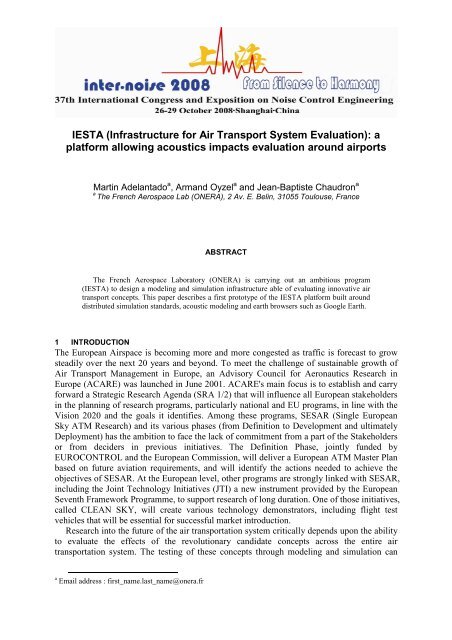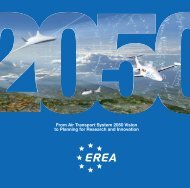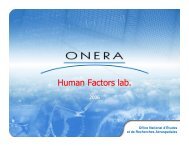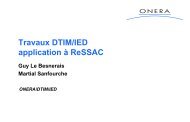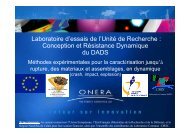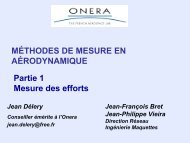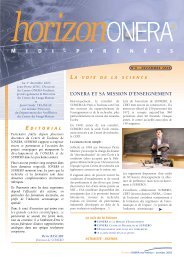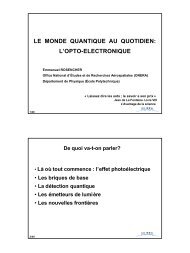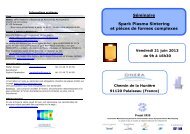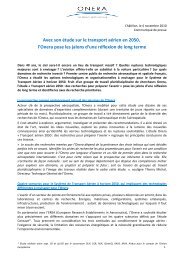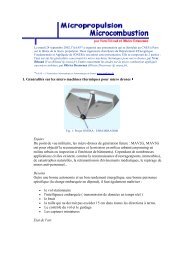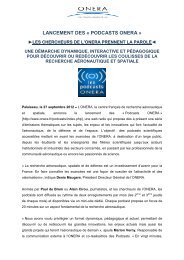IESTA (Infrastructure for Air Transport System Evaluation): a ... - Onera
IESTA (Infrastructure for Air Transport System Evaluation): a ... - Onera
IESTA (Infrastructure for Air Transport System Evaluation): a ... - Onera
You also want an ePaper? Increase the reach of your titles
YUMPU automatically turns print PDFs into web optimized ePapers that Google loves.
<strong>IESTA</strong> (<strong>Infrastructure</strong> <strong>for</strong> <strong>Air</strong> <strong>Transport</strong> <strong>System</strong> <strong>Evaluation</strong>): a<br />
plat<strong>for</strong>m allowing acoustics impacts evaluation around airports<br />
Martin Adelantado a , Armand Oyzel a and Jean-Baptiste Chaudron a<br />
a<br />
The French Aerospace Lab (ONERA), 2 Av. E. Belin, 31055 Toulouse, France<br />
ABSTRACT<br />
The French Aerospace Laboratory (ONERA) is carrying out an ambitious program<br />
(<strong>IESTA</strong>) to design a modeling and simulation infrastructure able of evaluating innovative air<br />
transport concepts. This paper describes a first prototype of the <strong>IESTA</strong> plat<strong>for</strong>m built around<br />
distributed simulation standards, acoustic modeling and earth browsers such as Google Earth.<br />
1 INTRODUCTION<br />
The European <strong>Air</strong>space is becoming more and more congested as traffic is <strong>for</strong>ecast to grow<br />
steadily over the next 20 years and beyond. To meet the challenge of sustainable growth of<br />
<strong>Air</strong> <strong>Transport</strong> Management in Europe, an Advisory Council <strong>for</strong> Aeronautics Research in<br />
Europe (ACARE) was launched in June 2001. ACARE's main focus is to establish and carry<br />
<strong>for</strong>ward a Strategic Research Agenda (SRA 1/2) that will influence all European stakeholders<br />
in the planning of research programs, particularly national and EU programs, in line with the<br />
Vision 2020 and the goals it identifies. Among these programs, SESAR (Single European<br />
Sky ATM Research) and its various phases (from Definition to Development and ultimately<br />
Deployment) has the ambition to face the lack of commitment from a part of the Stakeholders<br />
or from deciders in previous initiatives. The Definition Phase, jointly funded by<br />
EUROCONTROL and the European Commission, will deliver a European ATM Master Plan<br />
based on future aviation requirements, and will identify the actions needed to achieve the<br />
objectives of SESAR. At the European level, other programs are strongly linked with SESAR,<br />
including the Joint Technology Initiatives (JTI) a new instrument provided by the European<br />
Seventh Framework Programme, to support research of long duration. One of those initiatives,<br />
called CLEAN SKY, will create various technology demonstrators, including flight test<br />
vehicles that will be essential <strong>for</strong> successful market introduction.<br />
Research into the future of the air transportation system critically depends upon the ability<br />
to evaluate the effects of the revolutionary candidate concepts across the entire air<br />
transportation system. The testing of these concepts through modeling and simulation can<br />
a Email address : first_name.last_name@onera.fr
provide useful in<strong>for</strong>mation on improvements on system capacity/safety and related<br />
environmental impact. In this evolutionary European context, the French Aerospace<br />
Laboratory (ONERA) is carrying out an ambitious program (<strong>IESTA</strong>) to design a modeling<br />
and simulation infrastructure able of evaluating innovative air transport concepts. This<br />
plat<strong>for</strong>m has to be considered as a mean to help harmonization of pan-European assessment<br />
tools <strong>for</strong> innovative research on future <strong>Air</strong> <strong>Transport</strong> <strong>System</strong>s (ATS).<br />
This paper firstly introduces organizational issues of the <strong>IESTA</strong> Program focusing on<br />
expected benefits of the underlying approach from the customer's point of view. Then, we<br />
present the characteristics of every acoustics components implies in acoustics impacts<br />
evaluation around airport: Three phases are detailed: Pre-Simulation phase, Simulation phase<br />
and Post-Simulation phase. We then discuss system architectural issues of the plat<strong>for</strong>m as<br />
well as technological features. Finally, we give a detailed presentation of a rapid prototype of<br />
the first version (application) of <strong>IESTA</strong>, called Clean <strong>Air</strong>port, aiming at assessing noise<br />
impact during the Landing and Take-Off (LTO) phases on airports vicinity. This prototype<br />
has been design to evaluate the relevance and efficiency of a set of well known existing tools<br />
to achieve the requirements of <strong>IESTA</strong>/Clean <strong>Air</strong>port plat<strong>for</strong>m, focusing on noise propagation<br />
and impact. Tools used include the ONERA CERTI HLA Run-time <strong>Infrastructure</strong><br />
(http://www.cert.fr/CERTI/), X-Plane simulation outputs (X-Plane by Laminar Research,<br />
www.x-plane.com/), Google Earth and related tools.<br />
2 THE <strong>IESTA</strong> PROGRAM<br />
The ambition of the <strong>IESTA</strong> Program is to offer an infrastructure <strong>for</strong> evaluating future<br />
concepts <strong>for</strong> air transport systems through an advanced <strong>for</strong>malization procedure. This<br />
program then participates in the world wide ef<strong>for</strong>t to face the challenge of sustainable<br />
development and to achieve ambitious goals, particularly with regard to security,<br />
environment and capacity. <strong>IESTA</strong> unifies all the aeronautical skills of ONERA in physics<br />
modeling and its know-how in terms of system evaluation and simulation architecture to<br />
provide a unique service <strong>for</strong> the benefit of players in the air transport industry who are<br />
interested to evaluate the per<strong>for</strong>mance and impact of their innovations in a more<br />
comprehensive way.<br />
<strong>IESTA</strong> is a 5 years Program built around 2 main projects, <strong>IESTA</strong>/AMO the responsibility<br />
of which is to deliver a set of computational modules, and <strong>IESTA</strong>/IMI aiming at integrating<br />
those modules within a given computational plat<strong>for</strong>m. Computational modules include noise<br />
propagation, chemical species emission and propagation, engines burning, aircraft dynamics,<br />
aircraft planning and maneuvering on the airport layout, en route flight plans etc. A set of<br />
long term thematic studies are also carried out in parallel in order to model system<br />
components and evaluation methodologies through internal and external co operations. Two<br />
applications of <strong>IESTA</strong> have been selected in a previous specification phase, each one<br />
addressing a set of relevant study cases:<br />
1) Clean <strong>Air</strong>port (<strong>IESTA</strong>.V1 version), a set of computing facilities and models to<br />
assess the airport impact on environment in terms of noise and chemical emissions.<br />
2) SimSky (<strong>IESTA</strong>.V2 version) addressing evaluation of innovative ATS concepts<br />
across the entire airspace.<br />
A first version of <strong>IESTA</strong>/Clean <strong>Air</strong>port will be delivered by June 2009, while<br />
<strong>IESTA</strong>/SimSky version is expected to be available by 2011. The <strong>IESTA</strong> Program should lead<br />
to the availability of a unique plat<strong>for</strong>m benefiting from the ONERA aerospace research<br />
environment, a large scale computing power and the multidisciplinary teams of engineers and<br />
scientists. Exploitations plans of the plat<strong>for</strong>m are very similar to those of ONERA wind<br />
tunnel facilities. Customers (civil aviation authorities, aircraft industries, airlines, airport
management companies etc), bring their own models and concepts to evaluate, and ONERA<br />
provides the infrastructure, the simulations facilities and any further model if necessary. The<br />
customer property on data, models and simulation results is contractually preserved.<br />
3 PRE-SIMULATION COMPUTATIONS PHASE<br />
This phase allows execution of all software components which are cost consuming in terms<br />
of computation time, memory storage, data flow and, moreover, whose parameters are not<br />
dependent on simulation.<br />
ONERA (in particular DSNA Research Unit) has developed several noise simulation tools<br />
that will be integrated in the Clean <strong>Air</strong>port version of the <strong>IESTA</strong> plat<strong>for</strong>m. Among these<br />
tools, CESAR, JEDI and MINOTAURE are devoted to determination of noise sources,<br />
CESAR and BEMUSE are noise diffraction models, and SIMOUN and PARABOLE are<br />
noise propagation models.<br />
3.1 Local plane propagation<br />
Currently, CESAR is the unique tool capable of efficiently estimating the global noise<br />
issued by an aircraft, including noise contributions from the most active sources as well as<br />
diffraction phenomena over the aircraft structure. The underlying model is based on ray<br />
tracing methods consisting of computing all the rays from a noise source and achieving a<br />
given observation location either directly or through a set of reflections on intermediate<br />
surfaces. The different noise sources of an aircraft are introduced using analytical models,<br />
propulsion noise (jet, fan) and aero dynamical noise (slats, flaps, landing gears).<br />
For each aircraft, the software CESAR provides templates that are stored in a database in a<br />
binary <strong>for</strong>mat.<br />
3.2 Atmospheric propagation<br />
Based on ray tracing, SIMOUN has been designed <strong>for</strong> studying the long distance<br />
propagation of the “Concorde” sonic boom. From the aircraft trajectory, SIMOUN computes<br />
the ray propagation as well as their subsequent ground reflections. Propagation computing is<br />
per<strong>for</strong>med in 3D and uses the actual atmosphere properties following the ALADIN model<br />
developed METEO-FRANCE (http://www.meteofrance.com/). ALADIN is a limited area<br />
version of the ARPEGE system [1]: a numerical prediction system designed, developed and<br />
maintained in close collaboration with ECMWF (http://www.ecmwf.int/).<br />
In the same way that CESAR works, SIMOUN calculates fixture mitigation atmospheric<br />
which is stored in a database in a binary <strong>for</strong>mat, <strong>for</strong> a given ALADIN weather report.<br />
4 SIMULATION COMPUTATIONS PHASE<br />
Threw this phase, all software components participate in the HLA/RTI Simulation. They use<br />
results (CESAR and SIMOUN templates) provided by pre-simulation computation and takes<br />
into account all the dynamic parameters during the simulation itself.
4.1 Acoustic software organization <strong>for</strong> simulation<br />
The Acoustic HLA federate is built around 2 components:<br />
1) The ACOU_S component calculating the acoustic footprint <strong>for</strong> each aircraft.<br />
2) The CARTONOISE component encapsulating ACOU_S and producing the noise<br />
maps <strong>for</strong> each step of the simulation process.<br />
At each time step t i of the simulation phase CARTONOISE calculates an integrated<br />
acoustic map from all the aircraft participating in the simulation at time t i . CARTONOISE<br />
input data are broadcast by the scenario manager, the HLA federation and the ACOU_S<br />
component.<br />
4.2 The ACOU_S model<br />
ACOU_S handles the interface between the aircraft trajectories, CESAR model and<br />
SIMOUN code. ACOU_S has then been designed <strong>for</strong> computing the ground noise levels of a<br />
given aircraft at each time step. ACOU-S selects the template CESAR in the database based<br />
on the aircraft in question. In the same way, ACOU-S selects the template SIMOUN<br />
depending on the weather and given the altitude. There<strong>for</strong>e, all ACOU-S computations are<br />
per<strong>for</strong>med in real time starting from pre-calculated templates (CESAR and SIMOUN<br />
templates).<br />
10<br />
5<br />
0<br />
-5<br />
delta y (km)<br />
-10<br />
-15<br />
-20<br />
-25<br />
-30<br />
-35<br />
-40<br />
-30 -20 -10 0 10<br />
delta x (km)<br />
Figure 1: Noise footprint of an aircraft A K at a given frequency
As a result, ACOU_S produce the FOOTPRINT_ACOU_S noise footprint corresponding<br />
to the A K aircraft at t i time step. This footprint corresponds to an array of float values, the<br />
maximum dimensions of the array being:<br />
NFREQ x NPOINTS x 3.<br />
1) NFREQ = 24 corresponds to the well known ICAO frequencies (Annex 16 of ICAO).<br />
2) NPOINTS = number of sound points produced by FOOTPRINT_ACOU_S <strong>for</strong> each<br />
aircraft.<br />
3) 3 = 3-uplet consisting of X coordinate/Y coordinate and intensity.<br />
Figure 3 depicts an example of noise footprint with deltax (respectively deltay) is oriented<br />
to the East (respectively to the North), corresponding to Universal Transverse Mercator<br />
Projection.<br />
4.3 The CARTONOISE model<br />
At each time step t i the model proceeds in 3 steps included within a loop of N aircraft (A 1 ,<br />
A 2 … A K … A N ):<br />
1) For each aircraft A K recalling the noise footprint.<br />
2) Integration of this noise footprint within the noise map.<br />
3) Deletion of out of limits pixels.<br />
The first step (data recalling) proceeds as follows:<br />
Delta x and delta y coordinates of such a noise footprint from ACOU_S component cannot<br />
produce a noise grid using constant spatial resolutions. Recalling is then mandatory using<br />
spatial resolutions from the initialization phase.<br />
To explain in more details the recalling process, let us describe an example. Assuming that<br />
the initial spatial resolutions on ground are ∆X = ∆Y = 10 m, the output data of ACOU_S<br />
have to be located within a noise grid of identical spatial resolutions. Thus, <strong>for</strong> each (X, Y)<br />
coordinate of the noise footprint, the following trans<strong>for</strong>mation is applied:<br />
⎧<br />
⎛ X *1000 ⎞<br />
⎪X<br />
= ROUND ⎜ ⎟ * ∆X<br />
⎝ ∆X<br />
⎠<br />
⎨<br />
⎪<br />
⎛ Y *1000 ⎞<br />
Y = ROUND ⎜ ⎟ * ∆Y<br />
⎪⎩<br />
⎝ ∆Y<br />
⎠<br />
(1)<br />
Table 1 gives this recalling trans<strong>for</strong>mation <strong>for</strong> the described example.<br />
Table 1: Data recalling example when spatial resolutions are 10m<br />
ACOU_S output data<br />
Data after recalling<br />
X (km) Y (km) Intensity X (m) Y (m) Intensity<br />
-0,02 0,181 0,054 -20 180 0,054<br />
-0,022 0,464 0,058 -20 460 0,058<br />
-0,024 0,697 0,065 -20 700 0,065<br />
-0,028 1,002 0,075 -30 1000 0,075<br />
-0,031 1,202 0,083 -30 1200 0,083<br />
-0,035 1,451 0,093 -40 1450 0,093<br />
-0,041 1,781 0,108 -40 1780 0,108<br />
-0,049 2,251 0,131 -50 2250 0,131<br />
-0,063 3,003 0,168 -60 3000 0,168<br />
-0,091 4,658 0,253 -90 4660 0,253<br />
-0,104 5,569 0,301 -100 5570 0,301<br />
0,082 0,155 0,054 80 160 0,054
The recalling process can in some cases add redundancy in<strong>for</strong>mation on the noise<br />
footprint. Currently those redundancies are eliminated using a “weakest values elimination”<br />
algorithm.<br />
The second step (Noise footprint integration) consists in correctly positioning all the<br />
coordinates of the noise footprint within the integrated noise grid using a translation<br />
algorithm. This is due to the fact that the noise footprint of an aircraft AK is centered in a (0,<br />
0) coordinates point. However at time step t i the coordinates (X AK , Y AK ) of the AK aircraft<br />
regarding the integrated noise grid, are different. The following example explains the<br />
translation process: given a point P1 (X P1 , Y P1 ) of the noise footprint of the AK aircraft<br />
(centered in (0,0)), the translated coordinates regarding the integrated noise grid will be:<br />
⎛ X<br />
⎜<br />
⎝Y<br />
P1_<br />
NEW<br />
P1_<br />
NEW<br />
⎞ ⎛X<br />
⎟ = ⎜<br />
⎠ ⎝<br />
Y<br />
P1<br />
P1<br />
+ X<br />
+ Y<br />
A K<br />
A K<br />
⎞<br />
⎟<br />
⎠<br />
(2)<br />
Table 2 shows an integration process example considering that integrated data have been<br />
translated through X AK = 1270 m and Y AK = 3240 m.<br />
Table 2: Data integration example<br />
Recalling data<br />
Integrated data<br />
(local reference of the noise footprint)<br />
(local reference of the noise grid)<br />
X (m) Y (m) Intensity X (m) Y (m) Intensity<br />
-20 180 0,054 1250 -3060 0,054<br />
-20 460 0,058 1250 -2780 0,058<br />
-20 700 0,065 1250 -2540 0,065<br />
-30 1000 0,075 1240 -2240 0,075<br />
-30 1200 0,083 1240 -2040 0,083<br />
-40 1450 0,093 1230 -1790 0,093<br />
-40 1780 0,108 1230 -1460 0,108<br />
-50 2250 0,131 1220 -990 0,131<br />
-60 3000 0,168 1210 -240 0,168<br />
-90 4660 0,253 1180 1420 0,253<br />
-100 5570 0,301 1170 2330 0,301<br />
The third and last step (Deletion of inconsistencies) aims at eliminating all the noise pixels<br />
not participating in the integrated noise grid calculation regarding the aircraft locations in the<br />
local reference of the noise grid. Figure 2 illustrates how several noise footprints of<br />
individual aircraft are considered when the integrated noise grid is calculated (pixels colored<br />
in gray are eliminated).
Figure 2: Computation of the integrated noise grid from aircraft footprint<br />
5 POST-SIMULATION COMPUTATIONS PHASE<br />
This phase allows the use and exploitation of the grid noises calculated during the<br />
simulation. In a first step, we will explain the available operations of filtering to face with the<br />
user needs. Then in a second time, we will present the software named CARTOMETER<br />
which allows calculation of some well known metric such as LDEN metric.<br />
5.1 Filtering Computations<br />
Figure 2: Illustration <strong>for</strong> filtering computations<br />
Filtering operations allow refining selected grids provided by the simulation phase. On the<br />
same grid, it's possible to per<strong>for</strong>m spatially filtering (as x and y) in order to focus on an area
of interest. It is also possible to select a frequency range. Moreover, on the whole grid noise<br />
computed by the simulation, it is possible to extract grids <strong>for</strong> a given time interval of interest<br />
T. The figure 2 illustrates these treatments.<br />
5.2 The CARTOMETER model<br />
The software CARTOMETER is there<strong>for</strong>e a program of post-treatment which allows<br />
calculating some acoustics metrics. CARTOMETER uses noise grids produced during the<br />
simulation (acoustics intensities noise grid, units: Pa 2 ), which correspond to the time interval<br />
used to calculate these metrics. For the first release, we choose to implement well known<br />
algorithms to compute two metrics LAeq and L DEN .<br />
5.2.1 LAeq metric<br />
The metric LAeq (ISO 1996-2 (1987)) corresponds to the energy average sound level over<br />
a period T. This metric is expressed in dB (A).<br />
As show in Figure 3, this metric is calculated <strong>for</strong> each noise pixel (x i , y j ) and <strong>for</strong> a<br />
frequency f k of each grid noise (acoustics intensities noise grid, units: Pa 2 ) .<br />
Figure 3: LAeq computation from CARTONOISE ‘s noise grids<br />
The definition is as follows in equation 3:
LAeq(<br />
x , y<br />
⎛ EA(<br />
xi<br />
, y<br />
j<br />
, f<br />
⎜<br />
⎝ TP0<br />
, T ) ⎞<br />
⎟<br />
⎠<br />
k<br />
i j<br />
, f<br />
k<br />
, T ) = 10log10<br />
(3)<br />
2<br />
In this <strong>for</strong>mula, T represents the time interval considered and Po is the reference sound<br />
pressure (value: 2 * 10 -5 Pa). Moreover, EA (x i , y j ,f k ,T) is the A weighted energy <strong>for</strong> a pixel<br />
(x i , y j ) and <strong>for</strong> a frequency f k and defined as follows in equation 4:<br />
∫<br />
2<br />
EA(<br />
xi , y<br />
j<br />
, f<br />
k<br />
, T ) = PA ( xi<br />
, y<br />
j<br />
, f<br />
k<br />
, t)<br />
dt<br />
(4)<br />
T<br />
5.2.2 L DEN metric<br />
L DEN (European directive 2002/49/EC) is defined in terms of the “average” levels during<br />
daytime, evening, and night-time, and applies a 5 dB penalty to noise in the evening and a 10<br />
dB penalty to noise in the night. The definition is as follows in equation 5:<br />
DEN<br />
( x , y<br />
i<br />
j<br />
) = 10log<br />
10<br />
⎛<br />
⎜12×<br />
10<br />
⎜<br />
⎜<br />
⎝<br />
LDAY<br />
( xi<br />
, y j )<br />
10<br />
+ 4×<br />
10<br />
LEVENING<br />
( xi<br />
, y j ) + 5<br />
10<br />
24<br />
+ 8×<br />
10<br />
LNIGHT<br />
( xi<br />
, y j ) + 10<br />
10<br />
L (5)<br />
Here L DAY , L EVENING , and L NIGHT are the A-weighted long term LAeq <strong>for</strong> the day (6 a.m.-<br />
6 p.m.), evening (6 p.m.-10 p.m.), and night (10 p.m.-6 a.m.) determined over the year at the<br />
most exposed area of the airport layout. L DEN has been put <strong>for</strong>ward as the noise metric <strong>for</strong> the<br />
prediction of annoyance by most official organizations such as ACNUSA<br />
(http://www.acnusa.fr/) in France.<br />
⎞<br />
⎟<br />
⎟<br />
⎟<br />
⎠<br />
6 SYSTEM ARCHITECTURE DESIGN AND TECHNOLOGICAL ISSUES<br />
6.1 Reuse and Interoperability through Distributed Simulation<br />
The main goal of the <strong>IESTA</strong> Program is to provide a set of open, reusable, and<br />
interoperable modeling and simulation facilities to evaluate future ATM concepts and<br />
equipment. To achieve this goal, the High Level Architecture (HLA), an IEEE standard <strong>for</strong><br />
distributed simulation (IEEE 1516) has been selected to support interoperable simulations [2,<br />
3, 4, 5]. Motivations <strong>for</strong> HLA are the following:<br />
1) First of all, HLA offers a mean to increase the complexity of the modeled system by<br />
introducing additional components that can communicate through the RTI (Run-time<br />
<strong>Infrastructure</strong>), achieving then flexibility and scalability of the simulated system.<br />
There<strong>for</strong>e, it is not necessary, in a preliminary step of design, to incorporate all the<br />
components of the simulated system. This issue is of primary importance, since <strong>Air</strong><br />
<strong>Transport</strong> <strong>System</strong>s are very large, dynamic and complex systems with many<br />
interacting traffic modes and numerous services that have to share the same resources<br />
2) Secondly, HLA really offers a mean to face well-known site-proprietary constraints<br />
and to easily reuse existing models and simulations to design simulations of
increasing complexity and coverage.<br />
3) Thirdly, HLA faces with the lack of design methodologies in previous distributed<br />
simulation standards such as Distributed Interactive Simulation (DIS). It provides a<br />
Federation Development and Execution Process (FEDEP), standardized by IEEE<br />
since 2003 through a set of recommended practices [6].<br />
Several <strong>IESTA</strong> simulation technological solutions are very close to those adopted by the<br />
Virtual <strong>Air</strong>space Simulation Technology Real-Time (VAST-RT) Project at NASA Ames<br />
Research Center, part of the Virtual <strong>Air</strong>space Modeling and Simulation (VAMS) Project [7,<br />
8]. Furthermore, the adoption of HLA <strong>for</strong> <strong>IESTA</strong> benefits from the experience gained by<br />
ONERA from the “<strong>Air</strong>port of the Future” previous Project [9, 10, 11].<br />
6.2 <strong>IESTA</strong> Plat<strong>for</strong>m Architecture Design<br />
Figure 4: <strong>IESTA</strong> computational plat<strong>for</strong>m.<br />
The <strong>IESTA</strong> plat<strong>for</strong>m architecture, depicted in figure 1, is built around a set of computing<br />
resources, software and data bases devoted to a set of given functions and phases. In the<br />
following, these functions and components are briefly described:<br />
1) The Scenario Development and Plat<strong>for</strong>m Management (SDPM) function offers a<br />
set of tools to design the simulation scenario (airport selection, aircraft schedule,<br />
flights plans, fleet characteristics, etc). Other software are intended to handle the<br />
simulation phase (federates mapping, HLA federation initialization, run and
completion, replay, results files handling, etc).<br />
2) The HLA simulation phase consists of executing a given federation built around a<br />
set of participating federates using the Scenario Data base (SCBD) and the<br />
Technological Data base (TCBD). The TCBD contains all the physical data<br />
regarding aircraft characteristics, engine per<strong>for</strong>mances, weather, etc). Finally,<br />
simulation results are saved into the Results Data base (RSBD).<br />
3) The last phase is devoted to results analysis and visualization using a set of plotting<br />
and gridding software tools <strong>for</strong> computing noise and chemical species contours.<br />
High resolution LCD screens are devoted to simulation visualization and replay.<br />
7 RAPID PROTOTYPING OF <strong>IESTA</strong>/CLEAN AIRPORT PLATFORM<br />
7.1 Introduction<br />
As stated above, <strong>IESTA</strong>/Clean <strong>Air</strong>port will be the first version of the <strong>IESTA</strong> Plat<strong>for</strong>m<br />
aiming at assessing noise and chemical impact of aircraft around airport’s vicinity. The added<br />
value of this initiative versus well known tools as the Integrated Noise Model (INM) from<br />
FAA (http://www.faa.gov/about/office_org/headquarters_offices/aep/models/inm_model/)<br />
and the Emissions and Dispersion Modeling <strong>System</strong> (EDMS)<br />
(http://www.faa.gov/about/office_org/headquarters_offices/aep/models/edms_model/), deals<br />
with intensive use of the ONERA skills regarding noise propagation and chemical species<br />
dispersion modeling in the aerospace domain.<br />
This prototype has been designed to prepare the migration to HLA of ONERA existing<br />
models written in C language, Fortran or Matlab. Only a preliminary version of the acoustic<br />
propagation model has been integrated within the prototype, since the expected chemical<br />
emission and propagation models are not mature enough. An additional motivation in<br />
designing this <strong>IESTA</strong> prototype was to evaluate the ability of efficient tools such as Google<br />
Earth to display some results either during the simulation phase or during the post computing<br />
phase.<br />
The prototype, written in C++ language, is built with the free cross-plat<strong>for</strong>m Code::Blocks<br />
IDE (www.codeblocks.org) and runs on a PC under the Windows XP operating system.<br />
7.2 Scenario Generation and Simulation Steps<br />
7.2.1 Organization of the HLA federation<br />
The simulation prototype is an HLA federation consisting of only 2 federates:<br />
1) An <strong>Air</strong>craft Federate (AC_F) federate publishing the aircraft state vector (latitude,<br />
longitude, altitude, pitch, roll, heading, velocity, etc).<br />
2) An Acoustic Federate (ACOU_F) calculating the noise contours of a set of<br />
aircrafts around airport vicinity.<br />
The HLA Run-time <strong>Infrastructure</strong> used is an open source RTI designed by ONERA and<br />
called CERTI, freely available <strong>for</strong> download from the Web site (http://www.cert.fr/CERTI/).<br />
This RTI is US DoD 1.3 standard compliant, and is currently upgraded to the IEEE 1516<br />
HLA standard. Notice that the complete <strong>IESTA</strong>/Clean <strong>Air</strong>port plat<strong>for</strong>m will include<br />
additional federates such as ground planning/guidance models and engine burning models.<br />
These models are currently in a design state. Figure 5 provides a graphical view of both<br />
scenario generation and simulation phases.
<strong>Air</strong>craft Federate<br />
Acoustic Federate<br />
First step<br />
HLA simulation<br />
step<br />
Simulation<br />
Scenario<br />
CERTI<br />
RTI<br />
Google kml files<br />
Google network links<br />
Figure 5: Scenario generation and simulation steps.<br />
7.2.2 Scenario generation<br />
The first step consists of designing a simulation scenario. Currently we are using the<br />
capabilities of X-Plane flight simulator (X-Plane by Laminar Research, www.x-plane.com/).<br />
In the <strong>IESTA</strong> operational plat<strong>for</strong>m, ONERA custom models will be used to generate<br />
trajectories from flight plans. Those models are described in the following section.<br />
In the prototyping phase of <strong>IESTA</strong>, a simulation scenario is a set of trajectories provided<br />
be<strong>for</strong>e the simulation phase using X-Plane. Each trajectory consists of a set of parameters<br />
(aircraft vector state) including aircraft type, longitude, latitude, altitude, heading, pith, roll,<br />
speed, engine status and other parameters required by the acoustic model. Refer to section VI<br />
<strong>for</strong> a detailed explanation of the noise modeling. Each aircraft vector state is a set of time<br />
stamped measures, the acquisition rate being set by the X-Plane “pilot” be<strong>for</strong>e simulation (a<br />
rate of 1 measure every 2 sec has been selected). Flight plans can be introduced within the<br />
FMS of the simulated aircraft in two ways: in the first one, the “pilot” introduces himself the<br />
flight plan by selecting a set of waypoints (fix, VOR, NDB, runway ILS) and providing a<br />
given speed, altitude and climb/descent rate; another alternative is to use flight planners<br />
dedicated to X-Plane simulator, such as Goodway (http://www.xpgoodway.com/) or the<br />
Navigation tool of François Fouchet (http://francois.fouchet.free.fr/Navigation/). For<br />
example, the Goodway tool combines a powerful flight planner using all of the navaids and<br />
the airports of X-Plane, and an X-Plane plug-in allowing the “pilot” to automatically set up<br />
the flight plan into the FMS.<br />
Generation of an X-Plane trajectory from a given flight plan needs an additional free tool<br />
called Xplage developed by Chris Kern<br />
(http://www.chriskern.net/code/xplaneToGoogleEarth.html). Xplage is a software utility that
listens on an IP network <strong>for</strong> UDP datagrams representing the geographical coordinates of the<br />
simulated flight path of an instance of the X-Plane flight simulator, and then trans<strong>for</strong>ms them<br />
into a series of continuously updated KML files that Google Earth can ingest to create<br />
“moving map” displays. Section VII provides a more in depth explanation of both KML<br />
language and Google Earth display mechanisms.<br />
The main routine of the Xplage utility launches three asynchronous lightweight child<br />
processes which respectively wait <strong>for</strong> an incoming datagram from the simulator, the end of<br />
the specified interval <strong>for</strong> updating the KML output files, or a manual interrupt from the user.<br />
When the user issues a request to the interrupt thread to exit the program, all four processes<br />
are simultaneously terminated. The primary goal of the Xplage utility is to repeatedly<br />
generate two different KML files at a refresh interval specified by the user, allowing<br />
displaying two different views of the simulated aircraft through Google Earth. The first file is<br />
used by Google Earth to display an overhead map with North at the top and an icon in the<br />
center of the satellite image to indicate the position of the simulated aircraft. In this view, the<br />
Google Earth “eye” is fixed directly above the airplane. Each refresh cycle shifts the map in<br />
the direction of the flight path so as to keep the icon centered. The second KML file is used<br />
by Google Earth to display a perspective view of the terrain ahead of the simulated<br />
aircraft. In this view, the eye may be thought of as being right in front of the airplane and<br />
pointing slightly downward. Each refresh cycle repaints the perspective based on the<br />
simulated aircraft's roll and pitch orientation.<br />
Preparing the scenario uses an option of the Xplage command allowing the deposit of a<br />
file containing comma-separated values representing the flight track, in addition to the two<br />
KML files.<br />
Once a set of trajectories have been generated using X-Plane flight simulator, an<br />
additional scenario file is created containing the simulation starting time and the number of<br />
aircraft participating in the simulation. The trajectories files generated by both X-Plane flight<br />
simulator and Xplage utility are enriched by the simulation starting time of the corresponding<br />
aircraft and a string identifying the aircraft path. Simulation starting time of each<br />
participating aircraft is selected in such a way that the simulation scenario is realistic given<br />
the infrastructure and per<strong>for</strong>mances of the target airport.<br />
Recently a “real time” approach <strong>for</strong> generating the aircraft trajectories has been proposed<br />
by Jean-Michel Mathé (Jean-Michel.Mathe@onera.fr) from ONERA. This approach avoids<br />
generating the aircraft trajectories be<strong>for</strong>e the simulation phase. It is supported by the design<br />
of an X-Plane plug-in linked with the X-Plane API and the RTI CERTI libraries. This X-<br />
Plane plug-in automatically launches an HLA federate when the flight simulator is started. In<br />
a similar way as Xplage, the process waits <strong>for</strong> incoming datagrams from the simulator and<br />
published them to any federation. In that way trajectories generation can be per<strong>for</strong>med in real<br />
time launching several instances of the flight simulator connected with an Ethernet network.<br />
A receiving federate subscribing to the vector state attributes of the aircraft class (in the HLA<br />
sense), can then receive the vector state of each aircraft participating in the federation and<br />
immediately invoke the physical model of noise propagation.<br />
7.2.3 Simulation phases<br />
Once a scenario has been created, the simulation phase proceeds in two steps (figure 2).<br />
During the first step, the <strong>Air</strong>craft Federate (AC_F) creates a KML file <strong>for</strong> each participating<br />
aircraft, allowing Google Earth to display the trajectory of the aircraft and its starting location<br />
as well. Obviously, the user can seamlessly fly through the landscape with Google Earth<br />
navigation controls. Alternatively, the Acoustic federate (ACOU_F) creates a KML file to
display the reference grid around the airport. Noise impact from each aircraft as well as from<br />
all the participating aircraft will be further displayed at each point of the reference grid.<br />
Once the initial step has completed, each federate enters the main simulation loop. The<br />
<strong>Air</strong>craft federate proceeds according to the following algorithm:<br />
For each simulation time step do<br />
Activate waiting aircraft if their departure time is less than the current simulation time<br />
For each activated aircraft do<br />
Read the corresponding vector state from the file provided by X-Plane and Xplage<br />
Send the current vector state of the aircraft<br />
Create a KML Network Link file to display an overhead view through Google Earth<br />
Create a KML Network Link file to display a perspective view through Google Earth<br />
End <strong>for</strong><br />
Inactivate activated aircraft meeting their arrival time<br />
End <strong>for</strong><br />
Since the High Level Architecture is used, the <strong>Air</strong>craft Federate obviously publishes the<br />
vector state attributes of the aircraft class. Sending vector state attributes involves invocation<br />
of the RTI UpdateAttributesValues method. The time step is equal to the acquisition rate<br />
selected by the user be<strong>for</strong>e each X-Plane simulation. The first generated Network Link allows<br />
displaying an overhead map with an icon in the center of the satellite image to indicate the<br />
position of the simulated aircraft. In this view, the Google Earth “eye” is fixed directly above<br />
the airplane and follows the aircraft heading. The second KML Network Link is used by<br />
Google Earth to display a perspective view of the terrain ahead of the simulated aircraft.<br />
The algorithm of the Acoustic Federate is straight<strong>for</strong>ward. It subscribes to the vector state<br />
attributes of the aircraft class. Under reception of a set of state vectors corresponding to the<br />
simulated aircraft, it constructs the data structures needed by the noise model and<br />
immediately invokes the C++ method.<br />
The federate generates then several KML Network Links to display the current noise<br />
impact of the aircraft on the reference grid. One noise intensity matrix is created <strong>for</strong> each<br />
simulated aircraft as well as a global contribution matrix corresponding to all the aircraft<br />
currently in an active state. Notice that several snapshots of the displaying facilities offered<br />
by Google Earth will be described in section VII.<br />
Regarding the time management policy of the HLA federation, the <strong>Air</strong>craft Federate is<br />
regulating and the Acoustic Federate is declared to be constrained. Indeed, the role of the<br />
<strong>Air</strong>craft Federate is to synchronize its advancement according to the refresh rate of the X-<br />
Plane flight simulator in order to achieve a real time rendering of Google Earth.<br />
Finally, the simulation is initiated in the following way:<br />
1) Launching the CERTI HLA Run Time <strong>Infrastructure</strong>.<br />
2) Creating the federation by starting both federates, <strong>Air</strong>craft federate and Acoustic<br />
Federate.<br />
3) A first synchronization point allows the simulation to wait <strong>for</strong> launching Google<br />
Earth browser.<br />
4) A second HLA synchronization point waits <strong>for</strong> the user to type Enter be<strong>for</strong>e<br />
starting the HLA federation execution.<br />
Once Google Earth is launched, the user has to open all KML files and network links and<br />
to store them in the places panel of the browser. Each place can then be enabled or disabled<br />
according to the user needs regarding the visualization of the scenario and/or the noise impact<br />
on the reference grid.
8 REAL TIME VISUALIZATION OF NOISE IMPACT THROUGH GOOGLE EARTH<br />
8.1 Earth Browsers<br />
In recent years new innovative ways of providing geographical data has made geo-tagging<br />
and browsing of in<strong>for</strong>mation a popular way of sharing in<strong>for</strong>mation on the internet. For<br />
personal use, Google Maps and Google Earth (Google Earth is a registered trademark of<br />
Google Inc, http://earth.google.com/) can be freely downloaded and anyone can start using<br />
these powerful tools within minutes. Other well known 3D earth-browsers include NASA’s<br />
World Wind and Microsoft’s Virtual Earth.<br />
8.2 Keyhole Mark-up Language (KML)<br />
The Keyhole Mark-up Language (http://code.google.com/apis/kml/documentation/) is the<br />
XML based language used by Google Earth but also by other 2D map applications such as<br />
Google Maps and 3D earth-browsers like NASA’s World Wind and Microsoft’s Virtual<br />
Earth.<br />
Even if KML was originally developed by Keyhole, Inc (later acquired by Google) it is<br />
now considered a de facto standard <strong>for</strong> expressing geographic annotation and visualization.<br />
The current version, KML 2.2, has been submitted to the Open Geospatial Consortium <strong>for</strong><br />
standardization.<br />
A typical KML file includes a set of placemarks, images, polygons and 3D models used by<br />
applications to display geographical in<strong>for</strong>mation on a 2D map or in a 3D earth browser.<br />
To provide more dynamic contents the KML language provides a feature called Network<br />
Link. These links can be used to dynamically load other KML files provided through HTTP<br />
or a file-system. Network Links can be set up to be reload periodically at a given update rate.<br />
KML supports a feature called ground overlays allowing the user to include his own terrain<br />
imagery and maps, and place these over the imagery provided by Google Earth through their<br />
public servers.<br />
As an illustration, the following KML code is a Network Link defining the virtual camera<br />
that views the scene. The tags define the position of the camera relative to the Earth's surface<br />
(longitude, latitude, altitude) as well as the viewing direction of the camera (heading, roll,<br />
tilt).<br />
<br />
<br />
<br />
Perspective A320_Crusing_LFBO<br />
<br />
absolute<br />
1.243650<br />
43.449104<br />
2393.581121<br />
342.169586<br />
-18.771399<br />
90.000000<br />
<br />
<br />
Obviously, updating this Network Link file periodically, based on time and camera<br />
changes, allows refreshing the view according the simulated aircraft's roll and pitch<br />
orientation. In this way, Google Earth can display the scene view which may be thought of as<br />
being right in front of the aircraft.<br />
A useful advantage of Google Earth Browser and KML is also to encourage the design of<br />
a lot of freeware tools allowing the user to easily generate KML files and/or to display<br />
geographical data in a very efficient way. For example, GE-Path<br />
(http://www.sgrillo.net/googleearth/) was developed to construct paths and/or draw circles<br />
and polygons with place marks. EarthPlot (http://www.earthplotsoftware.com/) is a data<br />
analysis and visualization tool <strong>for</strong> Google Earth. EarthPlot processes geographic based data<br />
to generate a variety of maps within Google Earth. Data can be imported from several ASCII<br />
data <strong>for</strong>mats, in addition to being copied directly from a Microsoft Excel worksheet.<br />
8.3 Real Time Visualization through Google earth<br />
As mentioned above the <strong>IESTA</strong> prototype uses Google Earth to display real-time noise<br />
impact data calculated by the noise model. Recently, a very similar approach using Google<br />
Earth <strong>for</strong> scenario development and HLA federation test and integration has been described<br />
[12].<br />
8.3.1 Scenario Displaying<br />
The first use of Google Earth is to display the scenario be<strong>for</strong>e starting the simulation<br />
phase. As an illustration, Figure 6.a shows the Toulouse Blagnac <strong>Air</strong>port with 2 aircraft<br />
waiting <strong>for</strong> departure represented by green icons. In this example, the scenario consists of 5<br />
aircraft the trajectories of which are represented by the snapshot of figure 6.b. This figure<br />
also shows the 25km X 20km noise reference grid covering the Toulouse Blagnac <strong>Air</strong>port<br />
vicinity.<br />
<strong>Air</strong>craft trajectories are displayed by Google Earth through a set of KML files generated<br />
by the <strong>Air</strong>craft Federate during the first simulation step. Alternatively, the reference grid is a<br />
KML file generated by the Acoustic Federate from the location of a given reference origin<br />
(the control tower of the airport). During the simulation phase, those KML files can be<br />
enabled or disabled according to the user needs.<br />
6. a. Toulouse Blagnac airport 6. b. Reference grid and aircraft trajectories<br />
Figure 6: Scenario display through Google Earth.
8.3.2 Displaying the simulation current state<br />
Figure 7: Simulation state display<br />
Figure 7 is a snapshot displaying the simulation current state showing 3 activated aircraft<br />
represented by green, yellow and blue icons respectively. The noise reference grid has been<br />
disabled as well as the noise impact on the airport vicinity.<br />
Figure 8: Overhead and perspective views
Finally, figure 8 shows 2 different view of each simulated aircraft. The left part of the<br />
figure is a snapshot of the overhead view of an aircraft, and the right part is a snapshot of the<br />
perspective view from the same aircraft. Both views are displayed by Google Earth from 2<br />
KML Network Links generated by the <strong>Air</strong>craft Federate every 2 sec. The left view allows<br />
following the aircraft from the “eye” of Google Earth located above the aircraft. The right<br />
part of the figure shows the terrain ahead the simulated aircraft. The refresh rate of both<br />
network links can be selected by the user from the properties menu of each network link.<br />
8.3.3 Displaying noise impact<br />
Figure 9: Displaying noise impact<br />
Figure 9 shows a snapshot of the noise impact on the reference grid. The noise intensity<br />
given in db(A) is represented through color levels according to the color ramp displayed in<br />
the bottom right of the figure. Those grids are displayed by Google Earth through KML<br />
Network Links generated by the Acoustic Federate in real time with an updated rate of 2 sec.<br />
The user can enable the noise grid from each simulated aircraft individually or the noise grid<br />
of all the contributing aircraft. This figure represents in a colored <strong>for</strong>m the noise impact on<br />
the reference grid, from 3 currently activated aircraft. 2 aircraft are climbing after take off<br />
from Toulouse Blagnac <strong>Air</strong>port, and one aircraft is cruising at 1994 m altitude over the<br />
airport vicinity.
9 CONCLUSION<br />
This paper describes a rapid prototyping phase of the <strong>IESTA</strong> plat<strong>for</strong>m designed to provide<br />
customers simulation tools <strong>for</strong> evaluating environmental impact of innovative air transport<br />
concepts around airports. In this paper, we have shown how commonly available tools like<br />
Google Earth can be used to gain access to geodata and to display geographical output data of<br />
both a scenario and noise impact results. Obvious advantages are that more or less any<br />
geodata is available within minutes and at a cost close to zero.<br />
Finally we have shown how implementations of SISO standards (like HLA) can work<br />
together with major, mass-market oriented commercial applications like Google Earth. More<br />
generally, our experience shows that combining easily available tools such as X-Plane flight<br />
simulator, Google Earth browser and the High Level Architecture can provide powerful<br />
solutions to display complex results and scenario in an understandable, efficient and low cost<br />
manner. Moreover, HLA constitutes an efficient architecture to facilitate reuse of additional<br />
models and interoperability between them.<br />
This noise model allows calculating and displaying in real time impact results in a given<br />
airport vicinity. Furthermore, those results can be post computed to provide any kind of well<br />
known acoustics metrics such as LDEN, LAeq and EPNdB (not yet implemented).<br />
10 ACKNOWLEDGEMENTS<br />
The <strong>IESTA</strong> program is sponsored by several funding sources including the French “Midi-<br />
Pyrénées” Region, several Territorial Collectivities, French State and the European Fund <strong>for</strong><br />
the Regional Development (FEDER). The authors would like to thank all contributors to the<br />
<strong>IESTA</strong> Initiative and specially the research team members of the Long Term Research and<br />
<strong>System</strong>s Integration Department, Sébastien Aubry, Luis Basora, Muriel Brunet, Bruno<br />
Lamiscarre, Thomas Chaboud and Jean Hermetz. Jean Bulté, Jean Varnier and Yannick<br />
Rosenberg from the Computational Fluid Dynamics and Aero acoustics Department (DSNA)<br />
are greatly acknowledged <strong>for</strong> their active contribution to noise modeling within the <strong>IESTA</strong><br />
prototype. Finally, Jean-Michel Mathé and Eric Noulard, from the ONERA/DTIM<br />
Department have also to be acknowledged <strong>for</strong> their contribution (CERTI support and design<br />
of the X-Plane HLA Plugin).<br />
11 REFERENCES<br />
[1] Jean Pailleux, Jean-François Geleyn et Emmanuel Legrand "Numerical weather<br />
prediction with the models ARPEGE and ALADIN; assessment and prospects", June<br />
2000.<br />
[2] Kuhl, F., Weatherly, R., and Dahman, J., “Creating Computer Simulation <strong>System</strong>s: An<br />
Introduction to the High Level Architecture” Prentice Hall, ISBN 0-13-022511-8, 1999.<br />
[3] IEEE Std 1516-2000 TM , “IEEE Standard <strong>for</strong> Modeling and Simulation (M&S), High<br />
Level Architecture (HLA) - Framework and Rules,” September 2000.<br />
[4] IEEE Std 1516.1-2000 TM : “IEEE Standard <strong>for</strong> Modeling and Simulation (M&S), High<br />
Level Architecture (HLA) - Federate Interface Specification”, September 2000.<br />
[5] IEEE Std 1516.2-2000 TM : “IEEE Standard <strong>for</strong> Modeling and Simulation (M&S), High<br />
Level Architecture (HLA) - Object Model Template (OMT) Specification”, September<br />
2000.<br />
[6] IEEE Std 1516.3-2003 TM : “IEEE Recommended Practices <strong>for</strong> High Level Architecture<br />
(HLA) Federation Development and Execution Process (FEDEP)”, April 2003.
[7] Lehmer, R. D., Malsom, S. J., “Distributed <strong>System</strong> Architecture in VAST-RT <strong>for</strong> Real-<br />
Time <strong>Air</strong>space Simulation” AIAA Modeling and Simulation Technologies Conference,<br />
Providence, Rhode Island, August 2004, Paper # AIAA-2004-5436.<br />
[8] Web site of the NASA VAMS Project: http://vams.arc.nasa.gov/<br />
[9] Adelantado, M., “Rapid Prototyping of <strong>Air</strong>port Advanced Operational <strong>System</strong>s and<br />
Procedures through Distributed Simulation” AIAA Modeling and Simulation<br />
Technologies Conference, Providence, Rhode Island, August 2004, Paper # AIAA-<br />
2004-5436.<br />
[10] Adelantado, M., Bonnet, P., Latour, J. and Vincent, A., "Distributed Simulation <strong>for</strong><br />
Acquisition and Analysis of Future <strong>Air</strong>port Operational Concepts", AIAA Journal of<br />
Aerospace Computing, In<strong>for</strong>mation and Communication, Vol.1 n° 1, January 2004.<br />
[11] Adelantado, M., Damioli, C., and Dedieu, A., "A Reusable HLA Federation <strong>for</strong><br />
Simulation of <strong>Air</strong>port Traffic Assistance/Automation <strong>System</strong>s", 5 th IEEE International<br />
Conference on Intelligent <strong>Transport</strong>ation <strong>System</strong>s, Singapore, September 3-6, 2002.<br />
[12] Löfstrand, B., Möller, B., “Using Google Earth <strong>for</strong> Scenario Development and HLA<br />
Federation Test & Integration”, 2008 Spring Simulation Interoperability Workshop,<br />
Providence (RI), April 14-18, 2008.


